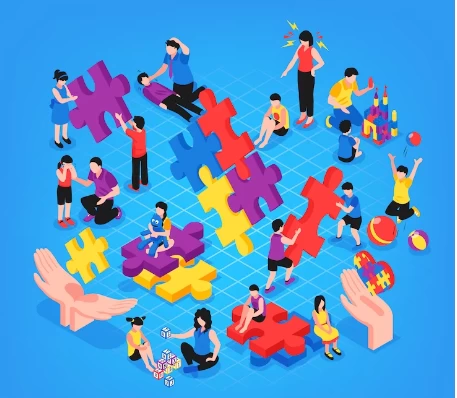
Autism and Neuroplasticity
- Autism and Neuroplasticity
- What is Autism?
- What is Neuroplasticity?
- Relationship between Autism and Neuroplasticity
- Approaches to Promote Neuroplasticity
- Limits of Neuroplasticity and Future Research
- In conclusion,
What is Autism?
Autism is a neurological disorder characterized by impairments in social interaction, communication, and repetitive behaviors. Autism typically begins in childhood and is often a lifelong condition. In recent years, significant progress has been made in understanding and addressing the effects of autism, leading to promising developments. Autism is also known as Autism Spectrum Disorder (ASD) because symptoms and manifestations can vary across a wide spectrum.
Autism spectrum disorder affects an individual's social interaction skills, communication abilities, and behaviors. People with autism may struggle with social interaction, such as making eye contact, sharing emotional reactions, or understanding social cues. They may also exhibit variations in communication skills, ranging from being nonverbal to having limited speech abilities. Additionally, individuals with autism may display repetitive and restricted patterns of behavior, such as specific rituals or fixations.
What is Neuroplasticity?
Neuroplasticity is a term that refers to the brain's ability to change structurally and functionally. Neurons, or nerve cells, in the brain can form new connections or strengthen existing ones through experiences and learning. This process allows for the reorganization of brain circuits through the strengthening or weakening of synaptic connections.
Neuroplasticity signifies the brain's capacity to change throughout life. Previously, it was believed that the brain was only plastic during childhood and that change was not possible in adulthood. However, recent research has shown that neuroplasticity exists in the adult brain as well.
Furthermore, neuroplasticity influences a range of brain functions, including learning, memory formation, the acquisition of motor skills, and the recovery process. For example, learning a new skill as an adult or acquiring a new language relies on neuroplasticity processes. These processes involve the establishment of new connections between nerve cells and the alteration of how the brain encodes and stores that new information.
Another remarkable feature of neuroplasticity is its role in the recovery process following brain damage. Functions lost as a result of brain injury can be compensated for by other brain regions through neuroplasticity mechanisms. For instance, an individual who has experienced a stroke can partially or completely transfer the functionality of the affected brain region to another region through the process of neuroplasticity.
In summary, neuroplasticity plays a crucial role in learning, rehabilitation, and the maintenance of brain health. Our experiences, education, social interactions, physical activities, and environmental factors can influence neuroplasticity. For example, engaging in challenging mental activities or regular exercise can promote neuroplasticity in the brain.
Relationship between Autism and Neuroplasticity
In individuals with autism, certain regions or circuits of the brain may function differently from typical individuals. This can have a negative impact on social interaction, language development, and other cognitive abilities. However, through neuroplasticity mechanisms, the brains of individuals with autism can adapt and form new connections.
Neuroplasticity holds promise as a treatment and intervention approach for individuals with autism. For example, early intervention programs aim to stimulate neuroplasticity in the brains of children with autism. These programs can help children improve their social skills, enhance communication abilities, and reduce repetitive behaviors.

Approaches to Promote Neuroplasticity
Cognitive Compensation: Using cognitive compensation strategies for individuals with autism can help them develop skills in areas where they may be lacking. For instance, visual supports, symbols, or signs can support communication skills.
- Intensive Behavioral Intervention: Intensive behavioral intervention programs are utilized to promote learning processes and enhance neuroplasticity in individuals with autism. These programs involve intensive and structured interactions tailored to specific goals.
- Cognitive Training: Providing cognitive training to individuals with autism can help improve their thinking skills. This training can stimulate neuroplasticity in areassuch as problem-solving, attention, and memory, thus promoting their development.
Sensory Integration Therapy: Sensory integration therapy can be used to manage sensory sensitivities commonly seen in individuals with autism. This therapy helps regulate responses to sensory stimuli by promoting the restructuring of synaptic connections in the brain.
Limits of Neuroplasticity and Future Research
While neuroplasticity holds promise as a treatment and intervention method for autism spectrum disorder, its effectiveness may vary among individuals. Each person with autism has a unique neurological profile, which may determine the limits of neuroplasticity.
Future research should focus on gaining a better understanding of neuroplasticity processes in individuals with autism and developing improved treatment methods. Advancements in brain imaging techniques and genetic studies can provide valuable insights into the underlying mechanisms of neuroplasticity and autism spectrum disorder. By further exploring the relationship between autism and neuroplasticity, we can continue to improve interventions and support for individuals with autism.
In conclusion,
Autism spectrum disorder is a neurological disorder characterized by impairments in social interaction, communication, and repetitive behaviors. Neuroplasticity plays a significant role in the ability of individuals with autism to change the structure and functionality of their brains. Therapies and interventions that promote neuroplasticity can help individuals with autism improve their social skills, communication abilities, and other cognitive functions. Future research will contribute to a better understanding of the relationship between autism and neuroplasticity, leading to the development of more effective treatment methods.
Ezgi KUTLU
- Special Education Teacher
- DIR Floortime Clinician
- Neuroplasticity Practitioner





